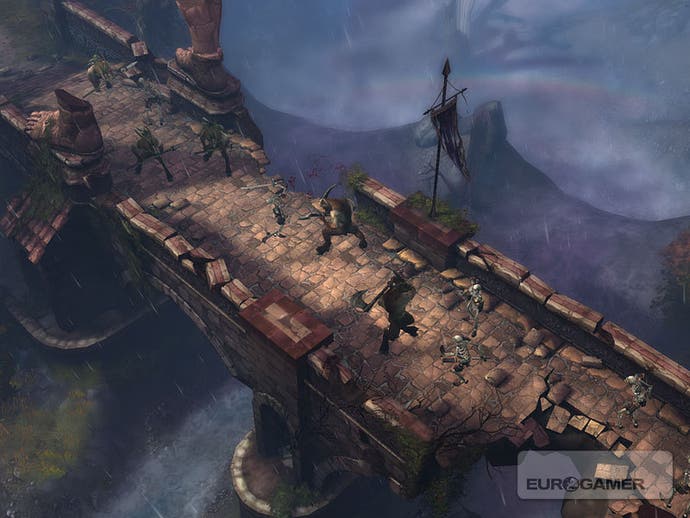Diablo III
Blizzard's next blockbuster dissected.
You've seen it in a hundred action games and platformers before, enemies dropping little red blobs that recharge your health. Simple, right? But think about the context, and the implications. Diablo's health system previously relied on potions that you could trigger at any time, and used up slots in your inventory and your action bar: gone, meaning more items and skills available, and a cleaner interface with more utility. The game now controls when you can recover health, and you don't. The pace, if anything, is even faster, the rhythm altered. Every fight in the scrambling thousands of them you'll have to do has the chance of going down to the wire, but the lower your health, the more you're going to want to fight.
"We kind of took cues from Halo and Call of Duty and first-person shooter games that do this all the time, they've gotten away from the med-pack concept but they both keep the pace high," says Pardo. "So if shooters can do that, it seems like we should be able to do the same thing, because we have the same goals."
It doesn't stop there. The trickle-down impact of health globes reaches into the very core of the game, changing balance, deepening the design the classes, and therefore the enemies they fight, and the situations they fight them in.
"Ultimately, if someone can always replenish their mana and replenish their health, then game balance kind of goes out the window," admits Pardo of the old potion system. "So it also allowed us to do more interesting things with the classes themselves. If you can't always just save yourself with a potion, then it makes other skills suddenly crucial for combat, like escape skills or crowd-control skills or things like that, which didn't really matter in the Diablo series previously."

"I would never put something like [health globes] on the back of the box," Pardo continues. "But I do think it's one of those features that's going to have a larger impact than some of the back-of-the-box features, for sure. The way we handled our death penalty in WOW is an example of that, because out of that decision came PVP being fun for more casual players, more casual players wanting to play and not lose experience when they die. A lot of things that came out of that kind of small decision ended up really having a large impact across the game. I definitely think this is in that category."
Health globes are even being used as a dynamic in the online co-operative play that Diablo III is designed around (although it will be solo-able in its entirety too, of course). When picked up, globes recharge the health of nearby party-members too, encouraging players to stick together and fight as a unit. A simple, brilliant touch, and just the beginning: Wilson promises "more elaborate" party dynamics will be revealed later. As for party size, it's undecided: "technically [the limit is] about eight, but we actually feel the game plays better with slightly fewer than that". Organised player-versus-player combat systems will be introduced later, too.
The more you hear and talk about it, the more it becomes apparent that there isn't a single aspect of Diablo III that isn't both deeper and more accessible than the previous games. That's an incredible design achievement by any yardstick. Wilson is particularly enthusiastic about the monster and boss design, which he promises will be a huge leap forward on what Diablo fans expect. "You will certainly see more complex bosses - we use games like Zelda and World of Warcraft as references for monster design and boss design. We definitely wanted to improve on that from Diablo II. We've made a lot of action-game improvements."

Zelda and Halo are two unexpected references that crop up several times over the weekend. "What I've learned as a designer over the years is it's just as important to play games outside the genre that you're making as it is to play games within it," says Pardo. "A lot of times within a genre, you kind of get in this insular thinking I think. You have to break out of that... I even came up with a little design tweak in StarCraft II that came from Rock Band."
You don't need to take their word for it. Watch the gameplay footage closely. Note how important positioning is, the extreme physicality of the skills: the way the Barbarian class, returning from Diablo II, strings his monstrous slams, whirlwinds and dashes together in criss-crossing combos that intricately, surgically dissect the crowds that overwhelm him.
Look at how ragdoll has been implemented so piles of zombie corpses slip off the edge of bridges in a tangle of flopping limbs. See that environmental destructibility is already more spectacularly and usefully implemented that it has been in a hundred shooters. Watch the ludicrous critical-hit explosions of chunks of monster flesh, straight from a console brawler. Diablo III isn't just Diablo II perfected, it's God of War redefined to boot.


.png?width=291&height=164&fit=crop&quality=80&format=jpg&auto=webp)




.jpg?width=291&height=164&fit=crop&quality=80&format=jpg&auto=webp)
